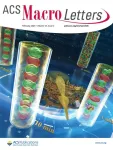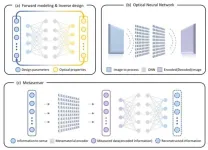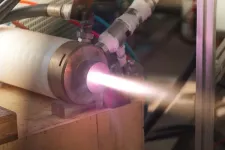Self-emergence of stational periodic arrangement of dual microdroplets through quasi one-dimensional confinement
Preserving the alignment of microdroplets sheds light on how biological molecules self-assemble and opens possibilities for creating artificial cells
2024-03-20
(Press-News.org)
Polymer systems composed of multiple components can spontaneously induce emulsion or microdroplets by mechanical mixing, as an intermediate state of macroscopic phase separation. Unfortunately, the size of generated droplets is nonuniform and their spatial-arrangement is rather random. In addition, they tend to grow larger with time (coarsening). To prevent the change of the microdroplet size, researchers have currently attempted to rapidly lower the temperature, but these efforts can never improve the uniformity of the droplets. If uniformly arranged homogeneous droplets entrapping certain substrates such as DNA and medicines can be produced in a simple procedure, these droplets will serve as useful items in drug delivery and also in creating synthesis cells. This self-organization of microdroplets can provide valuable insights into the self-assembly of biological molecules.
In a study made available online on January 24, 2024, and published in the journal ACS Macro Letters on February 20, 2024, a research team led by Ph.D. student Mayu Shono from the Department of Chemical Engineering and Materials Science at Doshisha University and including Koki Aburatani, Kenichi Yoshikawa, and Akihisa Shioi from Doshisha University and Miho Yanagisawa from The University of Tokyo, found that the homogeneous spatial pattern of microdroplets is spontaneously generated through phase separation of polymer solution along a glass capillary tube. Interestingly, it was shown that the uniformly arranged pattern of the droplets are rather stable for hours. The researchers confined an aqueous tripolymer solution containing polyethylene-glycol (PEG) mixed with dextran (DEX) and gelatin in a glass capillary tube coated with PEG. They observed that over time, the three phases separated, and the DEX and gelatin droplets aligned themselves in a periodic pattern in the PEG phase.
The spontaneous self-assembly arrangement occurred without any exchange of materials or energy in the system, setting it apart from other systems. “We have been performing our study to make clear the underlying mechanism of self-organization in living matter. As a result of this study, we have discovered a novel phenomenon for the generation of self-organized characteristic pattern,” says Ms. Shono.
In their experiments, the researchers prepared three aqueous tripolymer solutions, combining PEG, DEX, and gelatin with distilled water in a 5:4:6 weight ratio. To distinguish the molecules, they labeled the DEX and gelatin with fluorescent markers. These markers emit light of specific colors when exposed to light of certain wavelengths, allowing them to identify the different components in the sample. The solution was then drawn into PEG-coated capillary tubes with diameters of 140 μm and 280 μm.
Due to preferential attachment to the capillary's surface, PEG separated from the solution immediately. The DEX and gelatin phases, which were repelled from the inner wall, then formed droplets that increased in size. In 40 seconds, the DEX droplets formed a linear arrangement in the center of the capillary, and 120 seconds later, the gelatin droplets did the same. This led to a self-organized, periodic alignment of DEX- and gelatin-rich microdroplets surrounded by a PEG-rich phase, which maintained itself for eight hours after formation.
The essentials of the observed pattern are reproduced through numerical simulation by modifying the theoretical model with the Cahn-Hilliard equation, which describes the time-dependent change of the spatial pattern of phase separation in a mixture of three different polymers.
Achieving stable micropatterns through phase separations is challenging, because, in general, the microdroplets generated through phase transition are nonuniform and they tend to collapse or disappear with time. However, by confining them in a capillary with suitable chemical modification of its inner surface, the researchers were able to preserve the patterns for long periods. “The novel methodology to obtain uniform droplets reported here is superior to current microfluidics in several aspects,” says Ms. Shono.
In the future, such micropatterns can be studied to provide insights into the mechanisms involved in the self-assembly of biological molecules. Furthermore, it can aid in the development of targeted drug delivery and the production of desired macromolecules, such as proteins and nucleotides using protocells. It is to be noted that recently, Ms. Shono together with collaborators, has published an article indicating the successful selective entrapment of genome-sized DNA into the homogenous, arranged droplets (Small, 2023; DOI: 10.1002/smll.202302193). Sharing her concluding remarks, Ms. Shono says, “This scenario for pattern formation coupled with phase separation under confinement may provide a novel viewpoint to uncover the hidden factors for the origin of life and also to reveal the underlying mechanism on the stability of the structure and function of membrane-less organelles in living cells.”
About Mayu Shono from Doshisha University, Japan
Mayu Shono is a Ph.D. student at Doshisha University’s Department of Chemical Engineering and Materials Science. She has been carrying out scientific research concerning spatiotemporal self-organization on various hierarchical systems with the scale of nm-cm by combining experimental studies with theoretical analysis. Mayu has published six articles in reputed journals, including Small, Scientific Reports and Applied Physics Letters.
Funding information
This study was supported by the Japan Society for the Promotion of Science (JSPS) KAKENHI Grants 23KJ2081 (M.S.), 22H01188 (M.Y.), JP20H01877 (K.Y.), and 22K03560 (A.S.), and the JST FOREST (JPMJFR213Y, M.Y.).
Media contact:
Organization for Research Initiatives & Development
Doshisha University
Kyotanabe, Kyoto 610-0394, JAPAN
E-mail:jt-ura@mail.doshisha.ac.jp
END
[Attachments] See images for this press release:

ELSE PRESS RELEASES FROM THIS DATE:
2024-03-20
Getting the 988 and 911 emergency telephone systems to work in concert requires detailed planning and close cooperation, and such efforts may benefit from having one or two people at the local level who act as champions for interoperability, according to a new RAND report.
In order to make sure callers are routed to the appropriate system, efforts need to involve representatives from both 988 and 911 call centers, law enforcement, mobile crisis teams, peer support specialists, behavioral health specialists, and people who have lived experience
with crisis services, researchers say.
Local champions can aid such efforts by establishing priorities, convening local stakeholders,
brokering ...
2024-03-20
FAIRFAX, Va. (March 20, 2024)—A minimally invasive technique that uses ice to freeze and destroy small, cancerous tumors has now been proven effective for breast cancer patients with large tumors, providing a new treatment path for those who are not candidates for surgery, according to new research to be presented at the Society of Interventional Radiology Annual Scientific Meeting in Salt Lake City.
“For patients who have larger tumors but can’t undergo surgery, this approach could be more effective than the current standard of care for patients who are not surgical candidates,” ...
2024-03-20
FAIRFAX, Va. (March 20, 2024)—Early intervention with a minimally invasive treatment called uterine artery embolization (UAE) can help women avoid hysterectomy due to severe bleeding after childbirth, according to a new study being presented at the Society of Interventional Radiology Annual Scientific Meeting in Salt Lake City.
“These findings are important and may help more women avoid hysterectomy and other very serious complications of uncontrolled hemorrhage,” said lead author Younes Jahangiri, M.D., a third-year resident in the interventional and diagnostic radiology program at ...
2024-03-20
FAIRFAX, Va. (March 20, 2024)—A minimally invasive treatment using MRI and transurethral ultrasound instead of surgery or radiation is effective in treating prostate cancer, according to new research to be presented at the Society of Interventional Radiology Annual Scientific Meeting in Salt Lake City. The traditional treatment options of radiation or surgery often come with a risk of side effects, including urinary incontinence and erectile dysfunction that cause significant morbidity and adverse lifestyle effects. Researchers said that some patients now have a durable alternative for whole-gland treatment with MRI-guided transurethral ultrasound ablation (TULSA) that does not preclude ...
2024-03-20
Researchers exploring ways to utilise ChatGPT for work, say it could save organisations and individuals a lot of time and money when it comes to planning trips.
A new study, published in Innovations in Education and Teaching International (IETI), has tested whether ChatGPT can be used to design University field studies. It found that the free-to-use AI model is an effective tool for not only planning educational trips around the world, but also could be used by other industries.
The research, led by scientists from the University of Portsmouth and University of Plymouth, specifically ...
2024-03-20
A research team, comprising Professor Junsuk Rho from the Department of Mechanical Engineering, the Department of Chemical Engineering, and the Department of Electrical Engineering, and PhD candidates Seokho Lee and Cherry Park from the Department of Mechanical Engineering at Pohang University of Science and Technology (POSTECH), has recently published a paper that highlights the next generation of research trends that combine metaphotonics research with artificial intelligence. The paper has been published in the international journal, Current Opinion in Solid State and Materials Science.
Metalenses have sparked a revolution in optics, drastically ...
2024-03-20
Thanks for a new design contributed by a research team led by Prof. ZHAO Peng from Hefei Institutes of Physical Science (HFIPS) of Chinese Academy of Sciences (CAS), the operation time for plasma torch was extended from several days to several years.
"We made the world's longest-lasting plasma torch," said Prof. ZHAO.
Plasma torches, devices that generate thermal plasma, are pivotal in various industries due to their ability to efficiently produce high-temperature plasma. It can be applied in many fields including low-carbon metallurgy, powder spheroidization, carbon material preparation, and advanced ...
2024-03-20
People who are ‘double jointed,’ a condition formally known as generalised joint hypermobility, may be at heightened risk of long COVID, suggests a case-control study published in the open access journal BMJ Public Health.
They were 30% more likely not to have fully recovered from COVID-19 infection than those without hypermobile joints, and to be experiencing the persistent fatigue associated with long COVID, the findings indicate.
Other than older age, the likelihood of developing long COVID seems to be greater ...
2024-03-20
The air quality around planned new schools in England is “alarmingly poor,” with 86% of sites exceeding World Health Organization (WHO) targets on major air pollutants, reveals an analysis published online in the Archives of Disease in Childhood.
The consequences for health from exposure to excessive levels of air pollutants are well known, say the researchers, who call for air quality assessment at all stages of planning to be mandated, and legislation and guidance to be updated as a matter of urgency.
Children are particularly vulnerable to the harmful effects of air pollution, because their bodies, organs, and immune systems are still developing, explain ...
2024-03-20
A major report on the remains of a stilt village that was engulfed in flames almost 3,000 years ago reveals in unprecedented detail the daily lives of England’s prehistoric fenlanders.
Must Farm, a late Bronze Age settlement, dates to around 850BC, with University of Cambridge archaeologists unearthing four large wooden roundhouses and a square entranceway structure – all of which had been constructed on stilts above a slow-moving river.
The entire hamlet stood approximately two metres above the riverbed, with walkways bridging some of the main houses, and ...
LAST 30 PRESS RELEASES:
[Press-News.org] Self-emergence of stational periodic arrangement of dual microdroplets through quasi one-dimensional confinement
Preserving the alignment of microdroplets sheds light on how biological molecules self-assemble and opens possibilities for creating artificial cells



